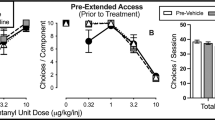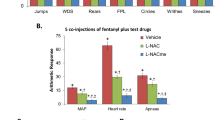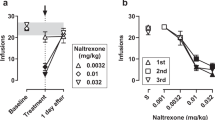Abstract
Rationale
Fentanyl is a potent mu-opioid receptor agonist that is widely used for the treatment of severe chronic pain. Discontinuation of fentanyl administration has been shown to induce a negative emotional state.
Objectives
The aim of the present studies was to investigate the effects of the partial mu-opioid receptor agonist buprenorphine on the negative emotional state associated with precipitated and spontaneous fentanyl withdrawal in rats.
Materials and methods
Fentanyl and saline were chronically administered via osmotic minipumps. A discrete-trial intracranial self-stimulation procedure was used to provide a measure of brain reward function. Somatic signs were recorded from a checklist of opioid abstinence signs.
Results
Naloxone induced a deficit in brain reward function in rats chronically treated with fentanyl. Buprenorphine dose-dependently prevented the naloxone-induced deficit in brain reward function. Discontinuation of fentanyl administration was also associated with a deficit in brain reward function. After explantation of the minipumps, the administration of buprenorphine induced a potentiation of brain reward function in the fentanyl-withdrawing rats, but did not affect brain reward function of saline-treated control rats. Buprenorphine prevented the somatic withdrawal signs associated with spontaneous fentanyl withdrawal and attenuated the somatic signs associated with precipitated fentanyl withdrawal.
Conclusions
Buprenorphine prevents affective and somatic fentanyl withdrawal signs. Moreover, buprenorphine is rewarding in rats previously exposed to fentanyl, but not in opioid-naïve rats. This pattern of results suggests that buprenorphine may be an effective treatment for the anhedonic-state associated with fentanyl withdrawal, but further study of buprenorphine’s abuse potential is warranted.




Similar content being viewed by others
References
Arnold JH, Truog RD, Orav EJ, Scavone JM, Hershenson MB (1990) Tolerance and dependence in neonates sedated with fentanyl during extracorporeal membrane oxygenation. Anesthesiology 73:1136–1140
Barr AM, Markou A (2005) Psychostimulant withdrawal as an inducing condition in animal models of depression. Neurosci Biobehav Rev 29:675–706
Bedi NS, Ray R, Jain R, Dhar NK (1998) Abuse liability of buprenorphine—a study among experienced drug users. Indian J Physiol Pharmacol 42:95–100
Bodkin JA, Zornberg GL, Lukas SE, Cole JO (1995) Buprenorphine treatment of refractory depression. J Clin Psychopharmacol 15:49–57
Bruijnzeel AW, Gold MS (2005) The role of corticotropin-releasing factor-like peptides in cannabis, nicotine, and alcohol dependence. Brain Res Brain Res Rev 49:505–528
Bruijnzeel AW, Markou A (2004) Adaptations in cholinergic transmission in the ventral tegmental area associated with the affective signs of nicotine withdrawal in rats. Neuropharmacology 47:572–579
Bruijnzeel AW, Lewis B, Bajpai LK, Morey TE, Dennis DM, Gold M (2006) Severe deficit in brain reward function associated with fentanyl withdrawal in rats. Biol Psychiatry 59:477–480
Carlezon WA Jr (2003) Place conditioning to study drug reward and aversion. Methods Mol Med 84:243–249
Carlezon WA Jr, Rasmussen K, Nestler EJ (1999) AMPA antagonist LY293558 blocks the development, without blocking the expression, of behavioral sensitization to morphine. Synapse 31:256–262
Chabal C, Erjavec MK, Jacobson L, Mariano A, Chaney E (1997) Prescription opiate abuse in chronic pain patients: clinical criteria, incidence, and predictors. Clin J Pain 13:150–155
Chen SA, O’Dell LE, Hoefer ME, Greenwell TN, Zorrilla EP, Koob GF (2006) Unlimited access to heroin self-administration: independent motivational markers of opiate dependence. Neuropsychopharmacology 31(12):2692–2707
Cowan DT, Wilson-Barnett J, Griffiths P, Allan LG (2003) A survey of chronic noncancer pain patients prescribed opioid analgesics. Pain Med 4:340–351
Dai S, Corrigall WA, Coen KM, Kalant H (1989) Heroin self-administration by rats: influence of dose and physical dependence. Pharmacol Biochem Behav 32:1009–1015
Dole VP, Nyswander ME, Kreek MJ (1966) Narcotic blockade. Arch Intern Med 118:304–309
Dominguez KD, Lomako DM, Katz RW, Kelly HW (2003) Opioid withdrawal in critically ill neonates. Ann Pharmacother 37:473–477
Easterling KW, Plovnick RM, Holtzman SG (2000) Acute opioid but not benzodiazepine dependence in rats responding for intracranial self-stimulation. Psychopharmacology (Berl) 148:263–271
Edwards G, Gross MM (1976) Alcohol dependence: provisional description of a clinical syndrome. Br Med J 1:1058–1061
Franck L, Vilardi J (1995) Assessment and management of opioid withdrawal in ill neonates. Neonatal Netw 14:39–48
Franck LS, Vilardi J, Durand D, Powers R (1998) Opioid withdrawal in neonates after continuous infusions of morphine or fentanyl during extracorporeal membrane oxygenation. Am J Crit Care 7:364–369
Franck LS, Naughton I, Winter I (2004) Opioid and benzodiazepine withdrawal symptoms in paediatric intensive care patients. Intensive Crit Care Nurs 20:344–351
Frederickson RC, Pinsky C (1975) Effects of cholinergic and anticholinergic drugs and a partial cholinergic agonist on the development and expression of physical dependence on morphine in rat. J Pharmacol Exp Ther 193:44–55
Gellert VF, Holtzman SG (1978) Development and maintenance of morphine tolerance and dependence in the rat by scheduled access to morphine drinking solutions. J Pharmacol Exp Ther 205:536–546
Gilson AM, Ryan KM, Joranson DE, Dahl JL (2004) A reassessment of trends in the medical use and abuse of opioid analgesics and implications for diversion control: 1997–2002. J Pain Symptom Manage 28:176–188
Gopal S, Tzeng TB, Cowan A (2002) Characterization of the pharmacokinetics of buprenorphine and norbuprenorphine in rats after intravenous bolus administration of buprenorphine. Eur J Pharm Sci 15:287–293
Gowing L, Ali R, White J (2004) Buprenorphine for the management of opioid withdrawal. Cochrane Database Syst Rev CD002025
Henderson GL (1988) Designer drugs: past history and future prospects. J Forensic Sci 33:569–575
Hyman SE, Malenka RC, Nestler EJ (2006) Neural mechanisms of addiction: the role of reward-related learning and memory. Annu Rev Neurosci 29:565–598
Ide S, Minami M, Satoh M, Uhl GR, Sora I, Ikeda K (2004) Buprenorphine antinociception is abolished, but naloxone-sensitive reward is retained, in mu-opioid receptor knockout mice. Neuropsychopharmacology 29:1656–1663
Jeziorski M, White FJ, Wolf ME (1994) MK-801 prevents the development of behavioral sensitization during repeated morphine administration. Synapse 16:137–147
Joranson DE, Ryan KM, Gilson AM, Dahl JL (2000) Trends in medical use and abuse of opioid analgesics. JAMA 283:1710–1714
Katon W, Egan K, Miller D (1985) Chronic pain: lifetime psychiatric diagnoses and family history. Am J Psychiatry 142:1156–1160
Kayemba-Kay’s S, Laclyde JP (2003) Buprenorphine withdrawal syndrome in newborns: a report of 13 cases. Addiction 98:1599–1604
Kenny PJ, Koob GF, Markou A (2003) Conditioned facilitation of brain reward function after repeated cocaine administration. Behav Neurosci 117:1103–1107
Koob GF, Le Moal M (1997) Drug abuse: hedonic homeostatic dysregulation. Science 278:52–58
Koob GF, Caine SB, Parsons L, Markou A, Weiss F (1997) Opponent process model and psychostimulant addiction. Pharmacol Biochem Behav 57:513–521
Kornetsky C, Esposito RU (1979) Euphorigenic drugs: effects on the reward pathways of the brain. Fed Proc 38:2473–2476
Kreek MJ (2000) Methadone-related opioid agonist pharmacotherapy for heroin addiction. History, recent molecular and neurochemical research and future in mainstream medicine. Ann N Y Acad Sci 909:186–216
Kreek MJ, LaForge KS, Butelman E (2002) Pharmacotherapy of addictions. Nat Rev Drug Discov 1:710–726
Kronstrand R, Druid H, Holmgren P, Rajs J (1997) A cluster of fentanyl-related deaths among drug addicts in Sweden. Forensic Sci Int 88:185–193
Kuhlman JJ Jr, McCaulley R, Valouch TJ, Behonick GS (2003) Fentanyl use, misuse, and abuse: a summary of 23 postmortem cases. J Anal Toxicol 27:499–504
Leander JD (1987) Buprenorphine has potent kappa opioid receptor antagonist activity. Neuropharmacology 26:1445–1447
Levine AS (2006) The animal model in food intake regulation: Examples from the opioid literature. Physiol Behav 89:92–96
Lilleng PK, Mehlum LI, Bachs L, Morild I (2004) Deaths after intravenous misuse of transdermal fentanyl. J Forensic Sci 49:1364–1366
Lin D, Bruijnzeel AW, Schmidt P, Markou A (2002) Exposure to chronic mild stress alters thresholds for lateral hypothalamic stimulation reward and subsequent responsiveness to amphetamine. Neuroscience 114:925–933
Linneman PK, Terry BE, Burd RS (2000) The efficacy and safety of fentanyl for the management of severe procedural pain in patients with burn injuries. J Burn Care Rehabil 21:519–522
Lintzeris N, Bammer G, Rushworth L, Jolley DJ, Whelan G (2003) Buprenorphine dosing regime for inpatient heroin withdrawal: a symptom-triggered dose titration study. Drug Alcohol Depend 70:287–294
Liu J, Schulteis G (2004) Brain reward deficits accompany naloxone-precipitated withdrawal from acute opioid dependence. Pharmacol Biochem Behav 79:101–108
Lohmann AB, Smith FL (2001) Buprenorphine substitution ameliorates spontaneous withdrawal in fentanyl-dependent rat pups. Pediatr Res 49:50–55
Mague SD, Pliakas AM, Todtenkopf MS, Tomasiewicz HC, Zhang Y, Stevens WC Jr, Jones RM, Portoghese PS, Carlezon WA Jr (2003) Antidepressant-like effects of kappa-opioid receptor antagonists in the forced swim test in rats. J Pharmacol Exp Ther 305:323–330
Mattick RP, Kimber J, Breen C, Davoli M (2004) Buprenorphine maintenance versus placebo or methadone maintenance for opioid dependence. Cochrane Database Syst Rev CD002207
Mello NK, Mendelson JH (1980) Buprenorphine suppresses heroin use by heroin addicts. Science 207:657–659
Mello NK, Bree MP, Mendelson JH (1983) Comparison of buprenorphine and methadone effects on opiate self-administration in primates. J Pharmacol Exp Ther 225:378–386
Millan MJ, Morris BJ (1988) Long-term blockade of mu-opioid receptors suggests a role in control of ingestive behaviour, body weight and core temperature in the rat. Brain Res 450:247–258
Milligan K, Lanteri-Minet M, Borchert K, Helmers H, Donald R, Kress HG, Adriaensen H, Moulin D, Jarvimaki V, Haazen L (2001) Evaluation of long-term efficacy and safety of transdermal fentanyl in the treatment of chronic noncancer pain. J Pain 2:197–204
Muijsers RB, Wagstaff AJ (2001) Transdermal fentanyl: an updated review of its pharmacological properties and therapeutic efficacy in chronic cancer pain control. Drugs 61:2289–2307
Ngai SH, Berkowitz BA, Yang JC, Hempstead J, Spector S (1976) Pharmacokinetics of naloxone in rats and in man: basis for its potency and short duration of action. Anesthesiology 44:398–401
O’Brien CP (1997) A range of research-based pharmacotherapies for addiction. Science 278:66–70
Ohtani M, Kotaki H, Uchino K, Sawada Y, Iga T (1994) Pharmacokinetic analysis of enterohepatic circulation of buprenorphine and its active metabolite, norbuprenorphine, in rats. Drug Metab Dispos 22:2–7
Parfitt T (2006) Designer drug Subutex takes its toll in Tbilisi. Lancet 368:273–274
Pfeiffer A, Brantl V, Herz A, Emrich HM (1986) Psychotomimesis mediated by kappa opiate receptors. Science 233:774–776
Saal D, Dong Y, Bonci A, Malenka RC (2003) Drugs of abuse and stress trigger a common synaptic adaptation in dopamine neurons. Neuron 37:577–582
San L, Cami J, Fernandez T, Olle JM, Peri JM, Torrens M (1992) Assessment and management of opioid withdrawal symptoms in buprenorphine-dependent subjects. Br J Addict 87:55–62
Schaefer GJ, Michael RP (1983) Morphine withdrawal produces differential effects on the rate of lever-pressing for brain self-stimulation in the hypothalamus and midbrain in rats. Pharmacol Biochem Behav 18:571–577
Schieffer BM, Pham Q, Labus J, Baria A, Van Vort W, Davis P, Davis F, Naliboff BD (2005) Pain medication beliefs and medication misuse in chronic pain. J Pain 6:620–629
Schulteis G, Markou A, Gold LH, Stinus L, Koob GF (1994) Relative sensitivity to naloxone of multiple indices of opiate withdrawal: a quantitative dose–response analysis. J Pharmacol Exp Ther 271:1391–1398
Shippenberg TS, Heidbreder C, LeFevour A (3-28-1996) Sensitization to the conditioned rewarding effects of morphine: pharmacology and temporal characteristics. Eur J Pharmacol 299:33–39
Shook JE, Watkins WD, Camporesi EM (1990) Differential roles of opioid receptors in respiration, respiratory disease, and opiate-induced respiratory depression. Am Rev Respir Dis 142:895–909
Stinus L, Cador M, Zorrilla EP, Koob GF (2005) Buprenorphine and a CRF1 antagonist block the acquisition of opiate withdrawal-induced conditioned place aversion in rats. Neuropsychopharmacology 30:90–98
Stolerman IP, Johnson CA, Bunker P, Jarvik ME (1975) Weight loss and shock-elicited aggression as indices of morphine abstinence in rats. Psychopharmacologia 45:157–161
Thornton SR, Smith FL (1997) Characterization of neonatal rat fentanyl tolerance and dependence. J Pharmacol Exp Ther 281:514–521
Todtenkopf MS, Marcus JF, Portoghese PS, Carlezon WA Jr (2004) Effects of kappa-opioid receptor ligands on intracranial self-stimulation in rats. Psychopharmacology (Berl) 172:463–470
Twite MD, Rashid A, Zuk J, Friesen RH (2004) Sedation, analgesia, and neuromuscular blockade in the pediatric intensive care unit: survey of fellowship training programs. Pediatr Crit Care Med 5:521–532
Tzschentke TM (2004) Reassessment of buprenorphine in conditioned place preference: temporal and pharmacological considerations. Psychopharmacology (Berl) 172:58–67
Van Ree JM, Gerrits MA, Vanderschuren LJ (1999) Opioids, reward and addiction: an encounter of biology, psychology, and medicine. Pharmacol Rev 51:341–396
Vanderschuren LJ, Kalivas PW (2000) Alterations in dopaminergic and glutamatergic transmission in the induction and expression of behavioral sensitization: a critical review of preclinical studies. Psychopharmacology (Berl) 151:99–120
Wauquier A, Niemegeers CJ (1976) Intracranial self-stimulation in rats as a function of various stimulus parameters. VI. Influence of fentanyl, piritramide, and morphine on medial forebrain bundle stimulation with monopolar electrodes. Psychopharmacologia 46:179–183
Acknowledgements
This work was funded by developmental funds from the Department of Psychiatry (University of Florida) and a National Institute on Drug Abuse grant (RO3 DA020502-01) to Adrie Bruijnzeel. The authors would like to thank Melissa Prado and George Zislis for excellent technical assistance.
Author information
Authors and Affiliations
Corresponding author
Rights and permissions
About this article
Cite this article
Bruijnzeel, A.W., Marcinkiewcz, C., Isaac, S. et al. The effects of buprenorphine on fentanyl withdrawal in rats. Psychopharmacology 191, 931–941 (2007). https://doi.org/10.1007/s00213-006-0670-2
Received:
Accepted:
Published:
Issue Date:
DOI: https://doi.org/10.1007/s00213-006-0670-2




